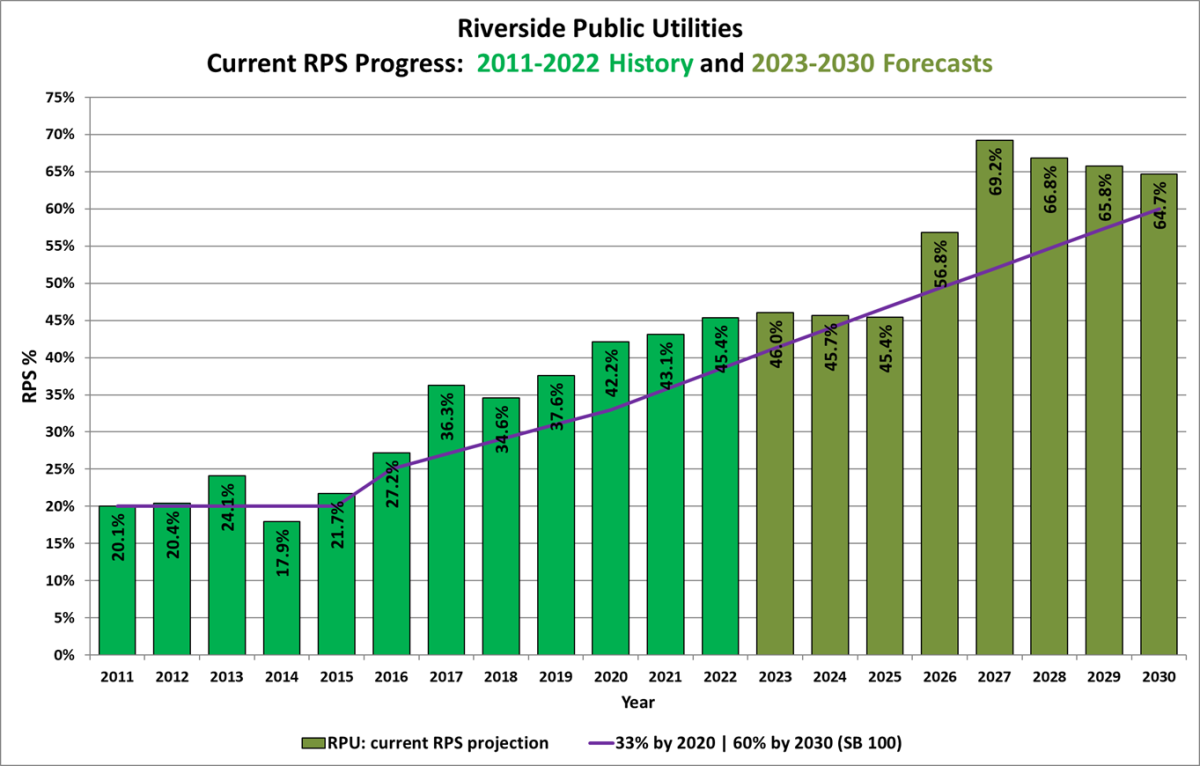Find info about the ROSA Division, Integrated Resource Plan, our Renewable Portfolio Standard and our Power Content Label.
Resource Operations and Strategic Analytics
Resource Operations & Strategic Analytics (ROSA) is made up of five core units. Three of these units are responsible for procuring, maintaining and managing RPU’s wholesale power resources. A fourth unit manages and maintains all our internal generation assets, and a fifth unit specializes in designing demand-side programs and services for RPU customers and integrating demand-side resources into our power supply portfolio.
Integrated Resource Plan Workshops
Learn about Riverside Public Utilities power resources and the roadmap to meet reliability,financial, and decarbonization goals.
Saturday, April 13, 2024
10 – 11:30 A.M.
Thursday, April 18, 2024
6 – 7:30 P.M.
RSSgt. Salvador J. Lara Casa Blanca Library
2985 Madison St.
Integrated Resource Plan (IRP)
Riverside Public Utilities 2023 Integrated Resource Plan (“2023 IRP”) provides an impact analysis of Riverside’s acquisition of new power resources, specifically towards meeting the state of California’s aggressive carbon reduction goals; along with the effect these resources will have on the utility’s future projected power supply costs. Read more.
Download Integrated Resource Plan
Both current and proposed supply-side and demand-side resources are examined in detail, towards a goal of continuing to provide the highest quality electric services at the lowest possible rates to benefit our local community, while adhering to a diverse set of state and regional legislative/regulatory mandates. Additionally, the 2023 IRP examines several related longer range planning activities, including battery energy storage (BES), transportation electrification (TE), distributed energy resources (DER), preliminary distribution system studies for accommodating increasing TE and DER penetration levels, and the utility’s current and future planned engagement with disadvantaged communities.In the most general sense, an IRP can be seen as a forward planning process for acquiring and delivering electrical services in a manner that meets multiple objectives for resource use. This 2023 IRP reviews and analyzes both intermediate term (5-year forward) and longer term (20-year forward) resource portfolio and energy market issues, along with the related longer range planning activities mentioned above. The goals of this IRP are multi-fold, but can be broadly summarized as follows:
-
To provide an updated overview of RPU’s (a) energy and peak demand forecasts, (b) current generation and transmission resources, and (c) existing electric system.
-
To review and assess the impact of important legislative and regulatory mandates imposed by various state or regional agencies (California Energy Commission, California Air Resources Board, South Coast Air Quality Management District, etc.), along with the impact of important active or proposed California Independent System Operator (CAISO) stakeholder initiatives.
-
To summarize and assess the utility’s current set of Energy Efficiency (EE) and Demand Side Management (DSM) programs and assess the overall cost-effectiveness of these EE/DSM programs with respect to both the utility and all utility customers (i.e., both participating and non-participating customers).
-
To review and quantify the most critical intermediate term power resource forecasts, specifically with respect to how RPU intends to meet its (a) projected energy, capacity, and resource adequacy requirements, (b) renewable portfolio standard (RPS) mandates, (c) carbon emission goals and mandates, and (d) power resource budgetary objectives.
-
To examine and analyze certain critical longer term power resource procurement strategies and objectives, specifically those that will help RPU reach its 2030 and 2040 carbon reduction goals and quantify how such strategies and objectives might impact the utility’s future power supply costs.
-
To begin to assess how various emerging technologies may concurrently impact RPU’s existing distribution system, to better define future actions that continue to support the utility’s fundamental objective of providing reliable electrical services at competitive rates.

Power Generation Assets
The Riverside Public Utility invested $250M in local power generation facilities to supply Riverside customers with the most reliable electric power available. The three power plants deliver 262 megawatts when our customers need it, which is enough energy to power the entire City of Riverside on a typical winter day.
Eight generators supplying 232 megawatts of flexible power are connected directly to the City of Riverside power transmission system. An additional 30 megawatts of highly efficient co-generation power is located in the adjacent City of Corona. Public Utility employees operate and maintain all aspects of these power generation assets, which can deliver their energy in emergencies, during the hottest days in the summer or whenever the CAISO needs these units to preserve the system reliability of the grid. Additionally, these clean natural gas turbine generators can start in emergency conditions when no electrical power is available to import.
Renewable Energy in Riverside
For the last fifteen years, Riverside has actively contracted for fourteen cost effective, new long-term renewable resources with expected COD’s in the 2013-2027 timeframe. Riverside’s historic and forecasted renewable energy generation levels for the 2011-2030 time frame are shown below, along with our SB 100 mandated RPS goals. Excess procurement will be saved (“banked”) for use in later compliance years, and/or resold to other utilities for the benefit of Riverside ratepayers.
Power Content Label
Power comes in all shapes and sizes. The Power Content Label, designed by the California Energy Commission, keeps customers informed of the various resources that are used to make up the state of California's and Riverside's electric power.
By maintaining our long-term power agreements and building new power generation resources, Riverside Public Utilities upholds its obligation to provide safe, reliable power to our customer-owners. Additionally, we remain committed to supporting and increasing renewable energy resources in our power portfolio.
Learn more >>


